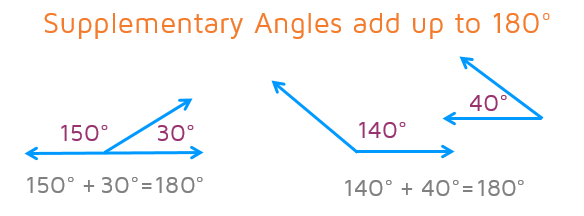

#Supplementary angle of 40 degrees how to#
We cover the criteria for supplementary angles, how to find them (which is an expansion of the above calculation), the properties of supplementary angles, the different types, and lots of examples to work through. If you want to learn more about the theory of supplementary angles and how they differ from complementary angles, we have a blog post that might help. If you'd like some ideas of angles to calculate, take a look at the random list in the sidebar and try to solve them without checking the answer first. Yes, the two angles together form a right angle.

Give this a try for yourself and try to work out the supplementary angles of any given angle which is less than 180°. When a pair of angles is said to be complementary, it means that the two angles add up to 90 degrees. This means that the supplementary angle of 140 degrees is 40 degrees. You should now be able to see the answer to this problem forming, as we just need to deduct 140 from 180 to get our supplementary angle:

Let's rearrange the equation using algebra to work out the supplement of 140°: What we need to do is solve this equation so that we can find S, the supplementary angle. We know that the supplementary angle added to the given angle of 140° equals 180 degrees. angle is angle 2 Example 27 degrees and 63 degrees since 27 63 90 In the second image the sum of angle measures is 50 40 90 Supplementary Angles. The normalised temperature separation between melting and spinodal temperatures, t + 1T m /T +, where t + (0, 0. To start with, let's set up the problem we are trying to solve as an equation. to the temperature dependence of s(T) allows us to obtain the equation of state for the protein system in the folded state. This is read as '34 degrees 24 minutes 16 seconds'. This form is used in astronomy and defining latitude and longitude. Each degree is divided into 60 minutes, and each minute further divided into 60 seconds. This is a very simple problem to solve, and we can work out the supplement of 140 degrees using some basic algebra. This calculator is used to add and subtract angles in the form Degrees - Minutes - Seconds (DMS). In this example, we are trying to calculate the supplementary angle for the given angle of 140 degrees. If the complement of an angle is 69° the angle wil… - ITProSpt.What is the Supplementary Angle of 140 Degrees?Ī supplementary angle is the angle which produces a straight line of 180° when added to the given angle. Construction of the angle pi/4=45 degrees produces . Hope this helps :)The following is a list of significant formulae involving the mathematical constant π. Use this calculator to find out the grade needed on the final exam in . Calculating hue angles can be a pain if you have to manually type values into a. Which pair of the following angles are complementary? Cielab Calculator - Schreiberei Rechel. The complement is shown by a little mark after the letter such as A' (or sometimes Ac or A ): P (A') means "Probability of the complement of Event A" The two probabilities always add to 1 P (A) + P (A') = 1 Example: Rolling a "5" or "6" Event A is Number of ways it can happen: 2 Total number of outcomes: 6 P (A) = 2 6 = 1 3 MCQ Questions for Class 7 Maths Chapter 5 Lines and Angles.


 0 kommentar(er)
0 kommentar(er)
